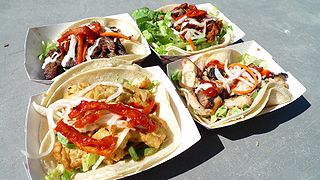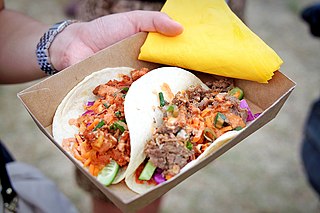 W
WBudae-jjigae or spicy sausage stew is a type of Korean jjigae (stew), made with ham, sausage, Spam, baked beans, kimchi, instant noodles, and gochujang. The dish was created shortly after the armistice that ended the Korean War, using the scrounged or smuggled surplus foods from U.S. military bases. Although the dish was born in the period of post-war impoverishment, it continued to be popular during the period of rapid growth, and is still popular today. There are many restaurants specializing in budae-jjigae, with the most famous ones on the budae-jjigae street in Uijeongbu, where the dish was allegedly first made. The dish is now a popular anju and a comfort food cooked on the table in a big pot in front of the diners and enjoyed as it is cooked for many Koreans.
 W
WDongaseu is a Korean dish which consists of a breaded, deep-fried pork cutlet.
 W
WHorumonyaki is a kind of Japanese cuisine made from beef or pork offal. Kitazato Shigeo, the chef of a yōshoku restaurant in Osaka devised this dish and registered a trademark in 1940. It was originally derived from Yakiniku. The name horumon is derived from the word "hormone", which means "stimulation" in Greek. The name horumon is also similar to the Kansai dialect term hōrumon (放る物), which means "discarded goods". Horumonyaki has a reputation for being a "stamina building" food.
 W
WA kimchi burger is a hamburger that includes kimchi in its preparation. Several restaurants serve kimchi burgers as part of their fare, including restaurants in South Korea, England and the United States. McDonald's restaurants in South Korea serve kimchi burgers. In addition to kimchi burgers being prepared using ground beef, they may be prepared using seafood, such as salmon. Kimchi burgers are sometimes topped with an egg, and may include additional ingredients such as mayonnaise, barbecue sauce and cilantro, among others.
 W
WKorean tacos are a Korean-Mexican fusion dish popular in a number of urban areas in the United States and Canada. Korean tacos originated in Los Angeles, often as street food, consisting of Korean-style fillings, such as bulgogi and kimchi, placed on top of small traditional Mexican corn tortillas. Korean burritos are a similarly themed dish, using larger flour tortillas as a wrap.
 W
WKorean–Mexican fusion is a type of fusion cuisine originally from Los Angeles that combines traditional elements of American-style Mexican food and Korean food. The earliest Korean-Mexican fusion featured Mexican or Tex-Mex dishes such as tacos or burritos filled with Korean-style barbecued meats and kimchi. Typical dishes include Korean tacos and bulgogi burritos. Food critics Jane and Michael Stern state that Korean–Mexican fusion is a growing food trend that has steadily gained in popularity since 2009.
 W
WMeat Jun is a Hawaiian dish of Korean origin, consisting of thinly sliced beef dipped in egg batter and fried. A type of jeon, it is a popular dish served at Korean restaurants in Hawaii, served both as an entree and part of a mixed plate lunch. It is usually served with a soy or gochujang based dipping sauce.
 W
WYakiniku, meaning "grilled meat", is a Japanese term that, in its broadest sense, refers to grilled meat cuisine. "Yakiniku" originally referred to western "barbecue" food, the term being popularized by Japanese writer Kanagaki Robun (仮名垣魯文) in his Seiyo Ryoritsu in 1872. The term later became associated with Korean-derived cuisine during the early Shōwa period. Due to the Korean War, the terms associated with Korea in Japan were divided into North Korea and South Korea (Kankoku); the reference to a "yakiniku restaurant" arose as a politically correct term for restaurants of either origin.